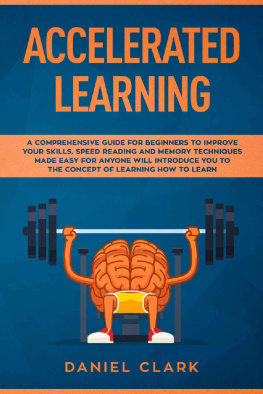First published in 2014
by Jessica Kingsley Publishers
73 Collier Street
London N1 9BE, UK
and
400 Market Street, Suite 400
Philadelphia, PA 19106, USA
www.jkp.com
Copyright Clark Baim 2014
Front cover image source: iStockphoto. The cover image is for illustrative purposes only, and any person featuring is a model.
All rights reserved. No part of this publication may be reproduced in any material form (including photocopying of any pages other than those marked with a

, storing it in any medium by electronic means and whether or not transiently or incidentally to some other use of this publication) without the written permission of the copyright owner except in accordance with the provisions of the Copyright, Designs and Patents Act 1988 or under the terms of a licence issued by the Copyright Licensing Agency Ltd, Saffron House, 610 Kirby Street, London EC1N 8TS. Applications for the copyright owners written permission to reproduce any part of this publication should be addressed to the publisher.
Warning: The doing of an unauthorised act in relation to a copyright work may result in both a civil claim for damages and criminal prosecution.
Library of Congress Cataloging in Publication Data
Baim, Clark.
Mindful co-working : the art of working together with confidence and enjoyment / Clark Baim.
pages cm
Includes bibliographical references and index.
ISBN 978-1-84905-413-3
1. Teams in the workplace. 2. Interpersonal relations. 3. Interpersonal communication. 4. Work environment--Social aspects. I. Title.
HD66.B32 2014
650.13--dc23
2013036952
British Library Cataloguing in Publication Data
A CIP catalogue record for this book is available from the British Library
ISBN 978 1 84905 413 3
eISBN 978 0 85700 803 9
Acknowledgements
I am grateful for the collaboration and ideas of many colleagues who have helped me develop as a co-worker and to think through the concepts in this book. I am profoundly grateful, first and foremost, to Mary Leyland, with whom I co-worked for nine intense years between 2000 and 2009. During our time as co-workers and co-trainers, working internationally, together we generated and refined many of the concepts in this book. We also trained several thousand professionals in the practical skills of mindful co-working. Mary has recently retired, and in my mind she remains the quintessence of the mindful co-worker. She models like no other the simple act of caring. She has devoted herself to protecting children, working with troubled families, helping people make life-saving changes, and training professionals to do the same. It was a pleasure and a privilege to co-work with her during what will always seem to me to be a golden period of work in my life, with the added bonus that this was work with a very dear friend.
I am also indebted to other people with whom I have had the privilege of co-working. On reflection, I seem to have been rather prolific in seeking opportunities to co-work. My best work has always come from collaboration with others, and recognizing this I wish to thank my co-workers past and present, including Lydia Guthrie, Susie Taylor, Fiona Macbeth, Tony Morrison, David Middleton, Joanna Bell, John Richards, Jane Wiffin, Joe Sullivan, Richard Bradbury, Dawn Fisher, Kerry Malone, Anita McLeod, Elizabeth Hayes, Richard Swann, Mel Thornton, Kristina Hofberg, Bridget Rothwell, Trudi Annetts, Jinnie Jefferies, Manuela Maciel, Jorge Burmeister, Alun Mountford, Sally Brookes, Andy Watson, Louise Heywood, Despina Visantiadou, Sanja Jagaric, Vedran Korusic, Annei Soanes, Peter Haworth, Sheila Foxgold, Bron Roberts, Peter Holden, Mark Farmer, Toni Philippides, Liz Murphy, Jackie Canicle, Panna Modi, Di Willetts, Roger Kennington, Gail McGregor, Dan Wilcox, Rita Donathy, Rosie Bampton, David Cook, Jenny King, Yvonne Rose, Gail Reed, Pat Lloyd, Clive Davies, Sally Tarpey, Jenny Stead, Keith Garrison, Sue Hunt, Sue Dunford, Ted Eames, Lynne Strong, Denise Hill, Dreda Wisniewska, Janet Cockerham, David Snooks, Ryan Hamilton, Emma Smallman, Mark Robinson, Mark Farrall, Hilary Dawson, Juliet Raynsford, Victoria Lee, Andy Marshall, Jez Thomas, Ken Guy, Ian Pringle, Jon Watson, Steve Morris, Dominic Somers, Tom Mellor, Yvonne Gregory, Kerry Reidy, Irene Brown, Adrian Dakers, Rhiannon Sawyer, Sue Deedigan, Jackie Evans, Karen Sweeney, Mark Londesborough, Camilla Gibbs, Saul Hewish, Simon Ruding, Patrick Tidmarsh, John Bergman, Tom Swift, Dan Brown, Ian MacKinnon, Shaun Landry, Scott Stevens, Mike Bael, Jill Reinier, Katy Emck, Ken Walker, Una Morton, Shannon Smy, Jim Tysver, Jo Hathaway, Jan Alcoe, and colleagues at Cheswold Park Hospital. I am very lucky to have met and collaborated with such dedicated and creative colleagues, and I am grateful for what I have learned from each of them about the art and craft of co-working. I also acknowledge and thank the many national and regional trainers, facilitators, customers and clients who have offered many suggestions for refinements along the way.
During the draft stages, a number of people have offered valued insights, feedback and suggestions for which I am very grateful. These include Chris and Joanna Brown, Clive Leyland, Lydia Guthrie, Liz White, Jeanne Burger, Patricia Crittenden, Sue Daniel, Annette Jackson, Pam Miranda, Sandie de Wolf, Amanda Kevin-Tidis, Marg Hamley, Amanda Jones, Trish McCluskey and many other colleagues at Berry Street/Take Two, Anna Mason, Christine Boal, Eden Baim and Alyson Coupe. I am also very grateful to the ever-encouraging team at Jessica Kingsley Publishers, including Steve Jones and Sarah Hull, and the cover designer Yvonne Booth.
Introduction
TWO OPENING VIGNETTES
As I was
The second item, covering events on a far larger scale, was headed, Military sex abuse rattles capital. The story was prompted by US Defense Department research estimating that 12,100 of the 203,000 women and 13,900 of the 1.2 million men in the US armed services experienced a sexual assault from fellow military personnel in 2012. This was 7000 more assaults than the previous year. President Obama and lawmakers on Capitol Hill were sharply focused on the issue, expressing zero tolerance for sexual harassment in the military.
Such sobering tales of violence and abuse in the workplace are certainly not unique; similar problems of interpersonal conflict and sexual harassment are found in many workforces, not just the medical field and the armed services. This violence and abuse, occurring in the working environment and among colleagues, may be seen as extreme forms of co-working gone wrong. It is behaviour that is strongly influenced by the environment and the organizational culture, and as such it can be foreseen and to a very great extent prevented. And while violence and sexual abuse in the workplace are shocking and awful, it is important to place them in the context of known behaviours, behaviours that we understand, and behaviours that are at the extreme end of a continuum of negative behaviours in the workplace that include at one end lack of interest or disharmony, worsening towards suspicion and hostility, and at the extreme opposite end, acts of violence and abuse. Wherever these behaviours are on the continuum, they can be predicted and largely curtailed with the right approach.



 , storing it in any medium by electronic means and whether or not transiently or incidentally to some other use of this publication) without the written permission of the copyright owner except in accordance with the provisions of the Copyright, Designs and Patents Act 1988 or under the terms of a licence issued by the Copyright Licensing Agency Ltd, Saffron House, 610 Kirby Street, London EC1N 8TS. Applications for the copyright owners written permission to reproduce any part of this publication should be addressed to the publisher.
, storing it in any medium by electronic means and whether or not transiently or incidentally to some other use of this publication) without the written permission of the copyright owner except in accordance with the provisions of the Copyright, Designs and Patents Act 1988 or under the terms of a licence issued by the Copyright Licensing Agency Ltd, Saffron House, 610 Kirby Street, London EC1N 8TS. Applications for the copyright owners written permission to reproduce any part of this publication should be addressed to the publisher.







